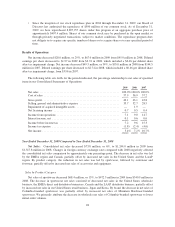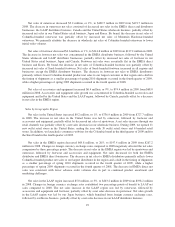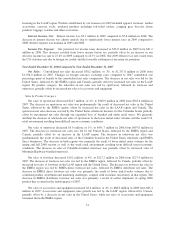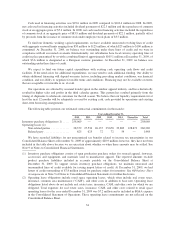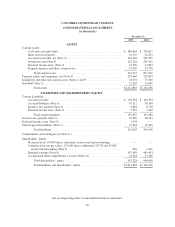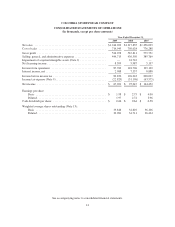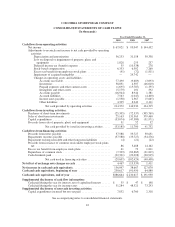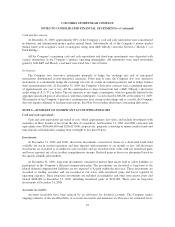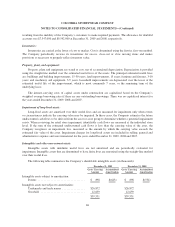Columbia Sportswear 2009 Annual Report Download - page 44
Download and view the complete annual report
Please find page 44 of the 2009 Columbia Sportswear annual report below. You can navigate through the pages in the report by either clicking on the pages listed below, or by using the keyword search tool below to find specific information within the annual report.undiscounted cash flows to be derived from the asset or asset group to determine whether a potential impairment
exists. When reviewing for retail store impairment, identifiable cash flows are measured at the individual store
level. If the sum of the estimated undiscounted cash flows is less than the carrying value of the asset, we
recognize an impairment loss, measured as the amount by which the carrying value exceeds the estimated fair
value of the asset. Our evaluations of impairment require estimates and assumptions about the forecasted amount
and duration of future cash flows and residual value, if any, attributable to assets being tested. Impairment
charges for long-lived assets are included in SG&A expense.
Income Taxes
We use the asset and liability method of accounting for income taxes. Under this method, we recognize
income tax expense for the amount of taxes payable or refundable for the current year and for the amount of
deferred tax liabilities and assets for the future tax consequences of events that have been recognized in our
financial statements or tax returns. We make assumptions, judgments and estimates to determine our current
provision for income taxes, our deferred tax assets and liabilities, and our uncertain tax positions. Our judgments,
assumptions and estimates relative to the current provision for income tax take into account current tax laws, our
interpretation of current tax laws and possible outcomes of current and future audits conducted by foreign and
domestic tax authorities. Changes in tax law or our interpretation of tax laws and the resolution of current and
future tax audits could significantly affect the amounts provided for income taxes in our consolidated financial
statements. Our assumptions, judgments and estimates relative to the value of a deferred tax asset take into
account predictions of the amount and category of future taxable income. Actual operating results and the
underlying amount and category of income in future years could cause our current assumptions, judgments and
estimates of recoverable net deferred taxes to be inaccurate. Changes in any of the assumptions, judgments and
estimates mentioned above could cause our actual income tax obligations to differ from our estimates, which
could materially affect our financial position and results of operations.
Our tax provision for interim periods is determined using an estimate of our annual effective tax rate,
adjusted for discrete items, if any, that are taken into account in the relevant period. As the calendar year
progresses, we periodically refine our estimate based on actual events and earnings by jurisdiction. This ongoing
estimation process can result in changes to our expected effective tax rate for the full calendar year. When this
occurs, we adjust the income tax provision during the quarter in which the change in estimate occurs so that our
year-to-date provision equals our expected annual effective tax rate.
Stock-Based Compensation
Stock-based compensation cost is estimated at the grant date based on the award’s fair value and is
recognized as expense over the requisite service period using the straight-line attribution method. We estimate
stock-based compensation for stock options granted using the Black-Scholes option pricing model, which
requires various highly subjective assumptions, including volatility and expected option life. Further, we estimate
forfeitures for stock-based awards granted, which are not expected to vest. If any of these inputs or assumptions
changes significantly, stock-based compensation expense may differ materially in the future from that recorded
in the current period.
Recent Accounting Pronouncements
See “Recent Accounting Pronouncements” in Note 1 to the notes to the consolidated financial statements.
37



